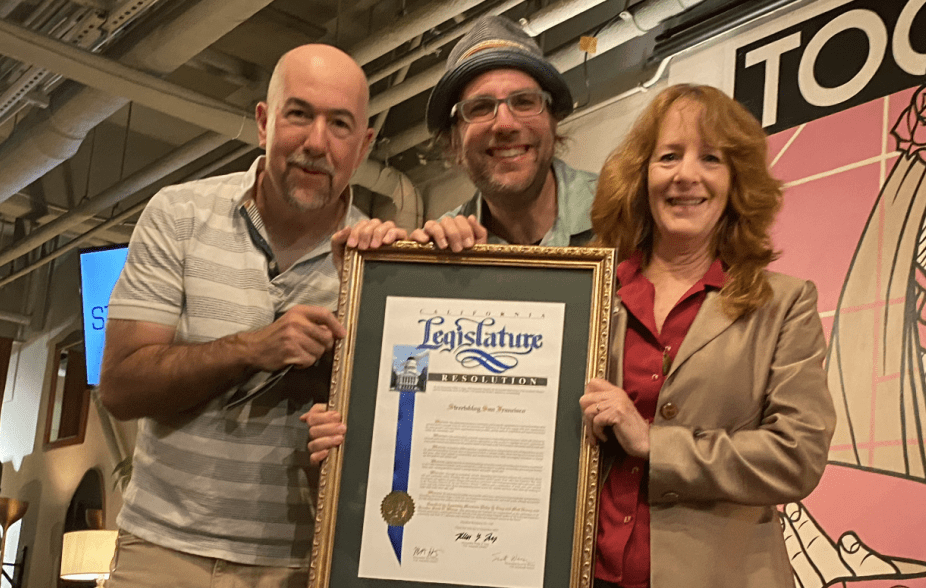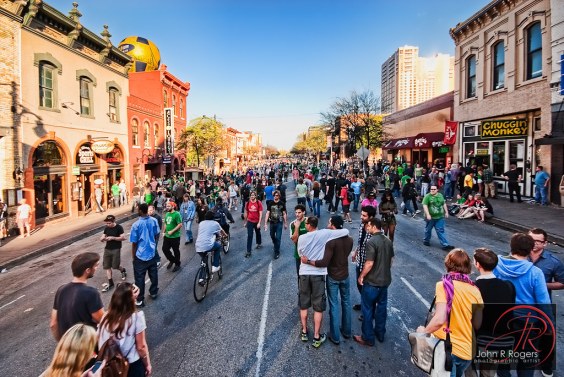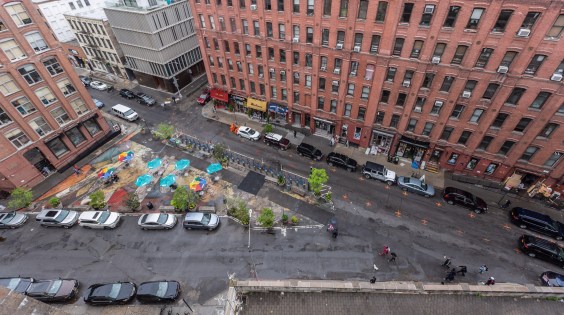 A photo simulation of the new Pavement to Parks public space in what was once two parking spaces in front of the Mojo Bicycle Cafe in NOPA. Image: RG Architecture.
A photo simulation of the new Pavement to Parks public space in what was once two parking spaces in front of the Mojo Bicycle Cafe in NOPA. Image: RG Architecture. With the success of San Francisco's Pavement to Parks trial plazas, the city is about to unveil its newest plan to use its streets for something other than cars when it converts parking spaces to public space by extending sidewalks into the street with durable wood platforms.
City planners acknowledge that the inspiration for these new pedestrian spaces came from the success of Park(ing) Day, an international sensation developed by Rebar, where people in cities around the globe occupy parking spaces for one day a year and build pocket parks and other innovative facilities.
The first iteration of the loosely dubbed Pavement to Parks 2.0 projects, which could happen in the next few weeks, will be the transformation of two parking spaces in front of Mojo Bicycle Café on Divisadero Street, in coordination with the massive construction project that is remaking the Divisadero corridor.
"The idea is essentially to build a cheaper bulbout, to get the same effect as a $100,000 [concrete] bulbout at a fraction of the funds," said the San Francisco Planning Department's Andres Power, project manager for Pavement to Parks. "We will take the occupation of a sidewalk off the sidewalk and move it into the parking lane."
District 5 Supervisor Ross Mirkarimi said he was an early champion of the project and, after seeing the impact of Park(ing) Day, he began talking with merchants along Divisadero about trying something like the temporary parking space interventions, but making them more permanent.
"I think San Francisco loves innovation," said Mirkarimi, adding that his district was a perfect location for the first trial of this kind given how many cyclists and pedestrians frequent the area. "There is a hipness that's part of Mojo's DNA as well as others on the Divisadero corridor."
As for the innovation of taking curb space that has been used for parking cars for more than half a century, the project is only possible because it is a trial, said Power. There was considerable debate about how to build a durable and attractive platform that wouldn't interfere with drainage and sanitation. The Department of Public Works (DPW), Planning, and the San Francisco Public Utilities Commission (PUC) landed on a solution they believe will be sturdy and safe, said Power.
The platforms will extend 7 feet from the curb, slightly less than the width of most cars, so vehicles that are parked at either end will serve as a buffer to passing traffic. Each parking space is approximately 20 feet long, so the Mojo platform will be just over 40 feet in length. Power said his department encouraged the designer to build a platform that would be modular and replicable, with the hope that more projects could be added in other parts of the city if this one is successful. Though the Chronicle reported that similar sidewalk extensions could be possible in North Beach, at Park(ing) Day sites like Caffe Greco and Caffe Roma, no one contacted for this story would confirm future locations.
 Image: RG Architecture
Image: RG Architecture Mayor Gavin Newsom's Office of Economic and Workforce Development provided a $5,500 grant to cover half the cost of the project, said Power, while the design and building costs were donated. The platform materials come from Bison Deck Supports, a company based in Boulder Colorado that traditionally builds roof decks, and the overall design came from RG Architecture. In addition to tables and chairs, the space will have bike racks and planter boxes, which will likely be filled with bamboo.
According to RG Architecture's Riyad Ghannam, nothing like this has ever come through his firm's door, which inspired him to offer his services gratis. "To me, in my business, it's 100 percent unique," he said of the project.
As for the age-old concern of merchants losing parking spaces, the businesses on Divisadero were more concerned about sidewalk space and bicycle parking, according to Remy Nelson, owner of Mojo Café and vice president of the Divisadero Merchants Association.
"I think it's really great," said Nelson. "My shop is in the middle of a block and when I look out my front window, I'm usually looking at parked cars."
Nelson explained that a shift had occurred with the merchants on his block and along the corridor in the past few years, as the perceived need for parking garages was replaced by calls for more pedestrian space and bicycle parking. Referring to the sidewalk extension in front of his business as a "no-brainer," Nelson predicted the transformation would catch on and other businesses would clamor for them.
"The public is going to see it and they're going to forget there ever was a parking lot there," he said.
The space will be maintained by Nelson and staff at Mojo, though the chairs and tables are open to the public, similar to the arrangement at the 17th Street and Castro trial plaza, where the movable tables and chairs are maintained by a business that fronts the pedestrian space.
The Mojo project received a similar six-month permit from the city as part of the Pavement to Parks trial plazas, which will have to be renewed if it is successful. Planners are waiting for the Department of Public Works (DPW) to finish the final elements of the Divisadero reconstruction before proceeding, though that could happen in the next few weeks, according to Power. All of the materials to build are in a warehouse and will be built as soon as the street is ready.
While Mayor Newsom has yet to announce the second generation of Pavement to Parks projects, Power said swift movement on the project and the coordination of all the agencies came from Astrid Haryati, the Mayor's Director of Greening, and Ed Reiskin, the Director of the DPW.
The speed of developing the project especially impressed Ghannam. "I have not seen anything like that procedurally," he said. "I think the city is taking a little bit of a chance, but sometimes you take a chance like this and you reap the rewards."
For Nelson, the project couldn't come quickly enough. "We need more emphasis on sidewalks, a place that's pleasant and fun to be in," he said. "How can we get it more sidewalk centric, less car-centric?"
 The Bison deck supports with adjustable heights will be important for negotiating the curve of Divisadero Street at the sidewalk. Image: Bison Deck Supports.
The Bison deck supports with adjustable heights will be important for negotiating the curve of Divisadero Street at the sidewalk. Image: Bison Deck Supports.  Image: RG Architecture.
Image: RG Architecture. 





